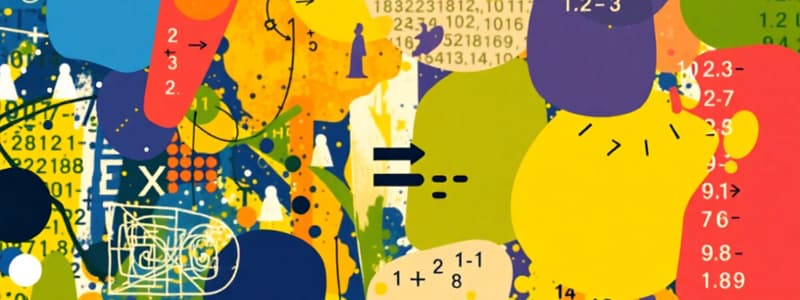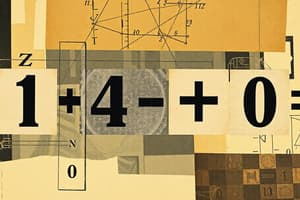Podcast
Questions and Answers
Subtraction is commutative, meaning a - b = b - a.
Subtraction is commutative, meaning a - b = b - a.
False (B)
The identity property of addition states that adding 0 to any number will not change its value.
The identity property of addition states that adding 0 to any number will not change its value.
True (A)
The distributive property applies to multiplication and states that a × (b + c) = a × b - a × c.
The distributive property applies to multiplication and states that a × (b + c) = a × b - a × c.
False (B)
Division is associative, meaning (a ÷ b) ÷ c = a ÷ (b ÷ c).
Division is associative, meaning (a ÷ b) ÷ c = a ÷ (b ÷ c).
The identity property of multiplication states that a × 1 = 0.
The identity property of multiplication states that a × 1 = 0.
The order of operations in calculations is represented by the acronym PEMDAS.
The order of operations in calculations is represented by the acronym PEMDAS.
Combining two or more numbers in addition results in a total greater than or equal to each individual number.
Combining two or more numbers in addition results in a total greater than or equal to each individual number.
For any numbers a and b, the expression a × b is always equal to b × a.
For any numbers a and b, the expression a × b is always equal to b × a.
The symbols used to represent addition include the minus sign (-).
The symbols used to represent addition include the minus sign (-).
The associative property of addition states that (a + b) + c = a + (b + c).
The associative property of addition states that (a + b) + c = a + (b + c).
Simple addition involves adding fractions and whole numbers.
Simple addition involves adding fractions and whole numbers.
When using column addition, numbers must be aligned correctly for an accurate sum.
When using column addition, numbers must be aligned correctly for an accurate sum.
Adding a number and its opposite results in that number itself.
Adding a number and its opposite results in that number itself.
Study Notes
Basic Fundamental Operations
1. Addition
- Combining two or more numbers to get a total.
- Symbol: +
- Properties:
- Commutative: a + b = b + a
- Associative: (a + b) + c = a + (b + c)
- Identity: a + 0 = a
2. Subtraction
- Finding the difference between two numbers.
- Symbol: -
- Properties:
- Not commutative: a - b ≠ b - a
- Not associative: (a - b) - c ≠ a - (b - c)
- Inverse of addition: a - b = a + (-b)
3. Multiplication
- Repeated addition of the same number.
- Symbol: × or *
- Properties:
- Commutative: a × b = b × a
- Associative: (a × b) × c = a × (b × c)
- Distributive: a × (b + c) = a × b + a × c
- Identity: a × 1 = a
4. Division
- Splitting a number into equal parts or finding how many times one number is contained in another.
- Symbol: ÷ or /
- Properties:
- Not commutative: a ÷ b ≠ b ÷ a
- Not associative: (a ÷ b) ÷ c ≠ a ÷ (b ÷ c)
- Inverse of multiplication: a ÷ b = a × (1/b) (if b ≠ 0)
5. Order of Operations
- Rules that determine the sequence to evaluate expressions.
- Mnemonic: PEMDAS/BODMAS
- P/B: Parentheses/Brackets first
- E/O: Exponents/Orders (powers and roots)
- MD: Multiplication and Division (left to right)
- AS: Addition and Subtraction (left to right)
- Important for ensuring consistent results in calculations.
Addition
- Combines two or more numbers to create a total, denoted by the symbol +.
- Commutative property allows the order of addends to change without affecting the sum: a + b = b + a.
- Associative property permits grouping changes without altering the result: (a + b) + c = a + (b + c).
- Identity property states that adding zero to any number does not change its value: a + 0 = a.
Subtraction
- Determines the difference between two numbers using the symbol -.
- Non-commutative property means the order matters: a - b ≠ b - a.
- Non-associative property indicates that regrouping does not yield the same outcome: (a - b) - c ≠ a - (b - c).
- Acts as the inverse of addition, expressed as: a - b = a + (-b).
Multiplication
- Represents repeated addition of a number, indicated by symbols × or *.
- Commutative property allows the factors to be swapped without affecting the product: a × b = b × a.
- Associative property enables changing the grouping of factors: (a × b) × c = a × (b × c).
- Distributive property connects multiplication with addition: a × (b + c) = a × b + a × c.
- Identity property confirms that multiplying by one leaves the number unchanged: a × 1 = a.
Division
- Involves splitting a number into equal parts or determining how often one number fits into another, symbolized by ÷ or /.
- Non-commutative property implies the order in division matters: a ÷ b ≠ b ÷ a.
- Non-associative property shows that the grouping of numbers affects the outcome: (a ÷ b) ÷ c ≠ a ÷ (b ÷ c).
- Acts as the inverse of multiplication, described as: a ÷ b = a × (1/b), applicable only when b ≠ 0.
Order of Operations
- Establishes rules for the sequence of evaluating mathematical expressions.
- Mnemonic PEMDAS/BODMAS aids memorization:
- P/B: Parentheses/Brackets take priority.
- E/O: Exponents/Orders (including powers and roots) come next.
- MD: Multiplication and Division are handled from left to right.
- AS: Addition and Subtraction are also processed from left to right.
- Following these rules ensures consistent and accurate results in calculations.
Definition and Symbols
- Addition is the process of combining two or more numbers to arrive at a total or sum.
- The operation of addition is denoted by the plus sign (+).
Components
- Addends: The individual numbers that are being added together.
- Sum: The resultant value obtained from adding the addends.
Properties of Addition
- Commutative Property: The order of addends can be changed without affecting the sum (e.g., a + b = b + a).
- Associative Property: Changing the grouping of numbers does not change the total sum (e.g., (a + b) + c = a + (b + c)).
- Identity Property: Adding zero to any number does not alter its value (e.g., a + 0 = a).
- Inverse Property: The sum of a number and its negative counterpart equals zero (e.g., a + (-a) = 0).
Types of Addition
- Simple Addition: Involves adding two or more whole numbers (e.g., 3 + 5 = 8).
- Column Addition: Aligns multi-digit numbers in columns to facilitate addition (e.g., 27 + 56).
- Mental Addition: Adding numbers in one’s mind without writing them down.
Applications
- Essential for everyday tasks such as shopping and budgeting.
- Serves as a foundational element in more advanced mathematical disciplines like algebra and calculus.
Example Problems
- Single-digit Addition: 4 + 7 results in 11.
- Multi-digit Addition: 123 + 456 results in 579.
- Word Problems: Example scenario includes having 3 apples and purchasing 5 more, leading to a total of 8 apples (3 + 5 = 8).
Common Mistakes
- Confusion between addition and subtraction operations.
- Misalignment of digits during column addition.
- Forgetting to carry over when sums exceed nine in multi-digit addition.
Tools for Learning
- Utilize number lines to visualize addition problems.
- Employ counters or manipulatives for an interactive learning experience.
- Use flashcards to practice and reinforce basic addition facts.
Studying That Suits You
Use AI to generate personalized quizzes and flashcards to suit your learning preferences.
Description
This quiz covers the basic fundamental operations in mathematics, including addition, subtraction, multiplication, and division. Each operation's properties, symbols, and examples are provided for better understanding. Test your knowledge on these essential mathematical concepts!




